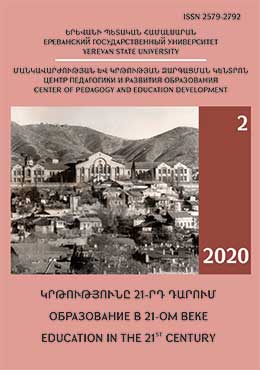FORMATION OF A CULTURE OF MOTION IN THE SYSTEM OF PHYSICAL EDUCATION
DOI:
https://doi.org/10.46991/educ-21st-century.v2i4.10886Keywords:
culture of movement, physical culture, education system, physical education, “school” of movements.Abstract
The article presents a theoretical analysis of the content of the concept of the culture of
movement, which in modern science is presented as a multifaceted phenomenon. As a
58
phenomenon of general culture, the culture of movement is considered as a process of using the
values of physical culture in various types of human motor activity.
The culture of movement, as a component of physical culture, is presented as a reflection of
all its aspects.
The formation of a culture of movement should be considered both as a task and as a result of
the process of physical education.
There are three levels of movement culture formation: basic, optimal and high.
The analysis of scientific and methodological literature on the problem under study made it
possible to single out a number of issues that remain insufficiently studied. Further research will
be aimed at determining the criteria for assessing the level of formation of the culture of
movement, the development of ways of its directed development in the process of physical
education.
References
Бальсевич В.К. Что нужно знать о движении человека: лекция // Физическая
культура: воспитание, образование, тренировка, 1997, № 2, с. 46-50.
Бернштейн Н. А., О построении движений. Медгиз, М., 1947, 254 с.
Евстафьев Б. В., Анализ основных понятий в теории физической культуры, Л.:
ВИФК, 1985, 118 с.
Завадич В. Н., Культура движений как проявление взаимодействия физического и
эстетического воспитания на уроках физической культуры // Вıсник Чернıгıвського
нацıонального педагогıчного унıверситету. Сер.: Педагогıчнı науки. Фıзичне виховання та
спорт, 2013, Вип. 112 (3), с. 201-203.
Земсков Е. А., Откуда что берется (о формировании осанки и походки у человека),
Физическая культура: воспитание, образование, тренировка, 1997, №1, с. 52-57.
Коренберг В. Б., Заметки о культуре движений // Гимнастика, М., 1974, с. 12-18.
Кучеренко Г. А., Двигательная культура младшего школьника и её влияние на лич-
ностное развитие в учебной деятельности Автореф дис.… канд пед наук. 2005, 21 с.
Матвеев Л. П., Теория и методика физической культуры, 3-е изд., перераб. И доп.,
М.: «Физкультура и спорт», СпортАкадемПресс, 2008, 544 с.
Медведева Е. С., Формирование культуры движений у студенток высших учебных
заведений. Автореф дис. … канд пед наук, 1998, 20 с.
Сараф М. Я., Столяров В. И Введение в эстетику спорта. / М. Я. Сараф, М.: ФиС,
, 104 с.
Телепина Т. С., Терентьева О. С., Двигательная культура школьника: ее основные
компоненты и условия формирования // Вестник Тамбовского Государственного
Университета. Вып.8 (124), 2013, с. 158-161.
Уткин В. Л., Культура движения (Основы оптимизации), М.: «Знание», 1984, 64 с.
Downloads
Published
How to Cite
Issue
Section
License

This work is licensed under a Creative Commons Attribution-NonCommercial 4.0 International License.

